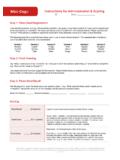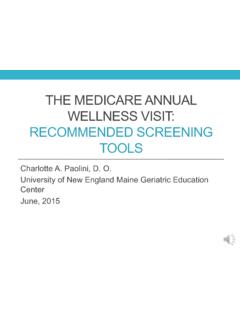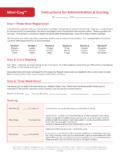Transcription of Mini-Cog™ Instructions for Administration & Scoring
1 mini -Cog Instructions for Administration & ScoringStep 1: Three Word RegistrationStep 2: Clock DrawingStep 3: Three Word RecallScoringLook directly at person and say, Please listen carefully. I am going to say three words that I want you to repeat back to me now and try to remember. The words are [select a list of words from the versions below]. Please say them for me now. If the person is unable to repeat the words after three attempts, move on to Step 2 (clock drawing).The following and other word lists have been used in one or more clinical For repeated administrations, use of an alternative word list is : Next, I want you to draw a clock for me. First, put in all of the numbers where they go. When that is completed, say: Now, set the hands to 10 past 11. Use preprinted circle (see next page) for this exercise. Repeat Instructions as needed as this is not a memory test. Move to Step 3 if the clock is not complete within three the person to recall the three words you stated in Step 1.
2 Say: What were the three words I asked you to remember? Record the word list version number and the person s answers List Version: _____ Person s Answers: _____ _____ _____Version 1 BananaSunriseChairVersion 4 RiverNationFingerVersion 2 LeaderSeasonTableVersion 5 CaptainGardenPictureVersion 3 VillageKitchenBabyVersion 6 DaughterHeavenMountainWord Recall: _____ (0-3 points)1 point for each word spontaneously recalled without Draw: _____ (0 or 2 points)Normal clock = 2 points. A normal clock has all numbers placed in the correct sequence and approximately correct position ( , 12, 3, 6 and 9 are in anchor positions) with no missing or duplicate numbers. Hands are pointing to the 11 and 2 (11:10). Hand length is not or refusal to draw a clock (abnormal) = 0 Score: _____ (0-5 points)Total score = Word Recall score + Clock Draw cut point of <3 on the mini -Cog has been validated for dementia screening, but many individuals with clinically meaningful cognitive impairment will score higher.
3 When greater sensitivity is desired, a cut point of <4 is recommended as it may indicate a need for further evaluation of cognitive S. Borson. All rights reserved. Reprinted with permission of the author solely for clinical and educational purposes. May not be modified or used for commercial, marketing, or research purposes without permission of the author : _____ Date: _____1. Borson S, Scanlan JM, Chen PJ et al. The mini -Cog as a screen for dementia: Validation in a population-based sample. J Am Geriatr Soc 2003;51:1451 Borson S, Scanlan JM, Watanabe J et al. Improving identification of cognitive impairment in primary care. Int J Geriatr Psychiatry 2006;21: 349 Lessig M, Scanlan J et al. Time that tells: Critical clock-drawing errors for dementia screening. Int Psychogeriatr. 2008 June; 20(3): 459 Tsoi K, Chan J et al. Cognitive tests to detect dementia: A systematic review and meta-analysis. JAMA Intern Med.
4 2015; McCarten J, Anderson P et al. Screening for cognitive impairment in an elderly veteran population: Acceptability and results using different versions of the mini -Cog. J Am Geriatr Soc 2011; 59: McCarten J, Anderson P et al. Finding dementia in primary care: The results of a clinical demonstration project. J Am Geriatr Soc 2012; 60: Scanlan J & Borson S. The mini -Cog: Receiver operating characteristics with the expert and naive raters. Int J Geriatr Psychiatry 2001; 16: DrawingID: _____ Date: _____Mini-Cog S. Borson. All rights reserved. Reprinted with permission of the author solely for clinical and educational purposes. May not be modified or used for commercial, marketing, or research purposes without permission of the author the mini -Cog mini -Cog ( )Screening for Cognitive Impairment in Older AdultsAdministering the mini -Cog The mini -Cog can be used as a cognitive vital sign and administered reliably with a little practice.
5 Instructions for Administration are provided on the testform available here. Once you start, complete the mini -Cog in one unit choose a time when interruptions and distractions are Make sure you have the patient s the patient to listen carefully to and remember three unrelated words and then to repeat the words back to you so then you will know theyheard the words correctly. You may want to say something like, What we re going to do next will take some concentration. Ready? 2. Ask the patient to repeat the words to ensure you are sure the patient is paying attention, say, I am going to say three words that I want you to remember now and later. The words are banana,sunrise, chair. Please say them now. Give the patient three tries to repeat the words. You may repeat the words to them for each try. If they are unable torepeat the words back to you after three tries, go directly to the clock the mini -Cog mini -Cog Ask patient to draw a the patient with page 2 of the Universal mini -Cog Instrument ( ).
6 Say all the following phrases in the order indicated below:1. Please draw a clock in the circle. It is acceptable to provide a sheet of paper with the circle already drawn for the patient, as depicted on thestandardized mini -Cog (insert hyperlink to the mini -Cog Tool page)2. Put all the numbers in the circle 3. When #2 is completed, say, Now set the hand to show ten past eleven. If the patient has not nished the clock drawing in 3 minutes, discontinue and ask for the word recall Ask patient to recall the 3 will be asking the patient to recall the set of 3 words you gave them at the beginning of the test. Say, What were the three words I asked you toremember? Administer this portion of the test even if the patient did not accurately repeat the 3 words earlier in #2 the mini -Cog mini -Cog ( )Screening for Cognitive Impairment in Older AdultsScoring the mini -Cog The mini -Cog is scored in two parts: 1) 3-item recall, and 2) clock drawing.
7 These are added together for a total Recall Score:1 point for each word recalled without cues, for a 3-item recall score of 1, 2, or Drawing Score:2 points for a normal clock or 0 (zero) points for an abnormal clock drawing. A normal clock must include all numbers (1-12), each only once, in the correctorder and direction (clockwise). There must also be two hands present, one pointing to the 11 and one pointing to 2. Hand length is not scored in the mini -Cog algorithm. TMTMN ormal ClockAbnormal Clock(abnormal hands)Abnormal Clock(missing number)







